- Retour accueil
- Vous êtes ici : Blog The Great Pyramid of Khufu / Dendera Temple The Dendera Light Bulb is a microdroplets fog made of sprayed water produced to achieve evaporative cooling inside the horizontal passage of the Great Pyramid of Khufu ©2021
The Dendera Light Bulb is a microdroplets fog made of sprayed water produced to achieve evaporative cooling inside the horizontal passage of the Great Pyramid of Khufu ©2021
Publié par Bruno Coursol dans The Great Pyramid of Khufu / Dendera Temple le 05/06/2021 à 15:13
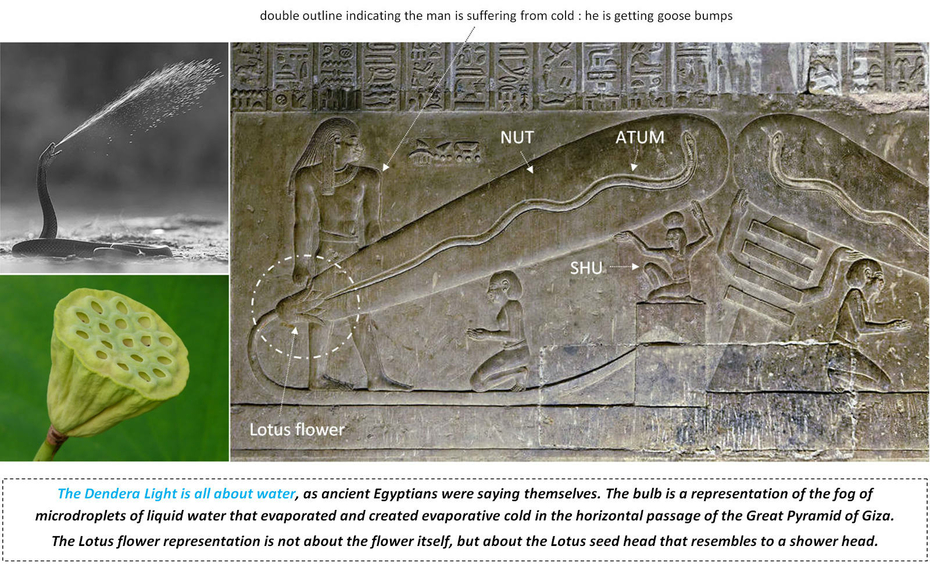
The Dendera Light in the Hathor temple, is a representation of the fog of microdroplets of liquid water, transforming itself in vapor and by doing so, creating the evaporative cold designed to cool down the Djed pillar (more probably a Solvay-like tower). The Light Bulb shape of the Dendera Light is constrained by the shape of the horizontal passage.
The snake inside the Dendera Light is a representation of the pressurized water of the inclined well and getting out of the fog nozzle of the pyramid (please read Section 5 on that matter : the waters of the inclined well). More on the Dendera Light in Section 2.
Photograph of the Dendera Light, thanks to Kairoinfo4U and posted on flickr : https://www.flickr.com/photos/manna4u/14525094039/in/photostream/
Lotus seed head thanks to Dinkum : https://commons.wikimedia.org/wiki/File:Nelumbo_nucifera_%28fruit%29.JPG
The ancient Egyptian Dendera Light "protective magical energy in liquid form" is the evaporative cooling fog
The fact that the Dendera Light is made of liquid water that transforms itself in a magical way, is exactly what are describing ancient Egyptians themselves :
[About the snake inside the Dendera Light Bulb] "The field surrounding Ra’s snake form is referred to in ancient Egyptian literature as protective magical energy in liquid form that all gods and pharaohs possess (Faulkner 1970*)." https://ahotcupofjoe.net/2016/11/dendera-light-bulb-and-bagdad-battery-nonsense/
*I'm not sure, but the excerpt might be from "The ancient Egyptian book of the dead / translated by Raymond O. Faulkner ; edited by Carol Andrews, 1972."
Evaporative cooling for the sodium carbonate manufacturing
My study is based on 2 key elements : the first one is the cold production inside the horizontal passage of the Great Pyramid ; and the second one is the production of sodium carbonate (pure natron), as suggested by the Red Pyramid.
The ammonia still present inside the Red Pyramid, indicates that they were using a sodium carbonate process identical or very close to the ammonia-soda process known as the Solvay process, developed into its modern form in the 1860s in Europe.
In the Solvay process, the ammonia only has a minor role ; but inside the Red Pyramid, my guess is that they didn't control the temperature of the different chemical reactions inside the Solvay towers. They couldn't cool down the towers.
That is the reason why they engineered the visible part of the Great Pyramid : to produce cold inside the horizontal passage, store it inside the Queen's chamber, and transfer it to the sodium carbonate production towers, passing through the Queen's chamber shafts.
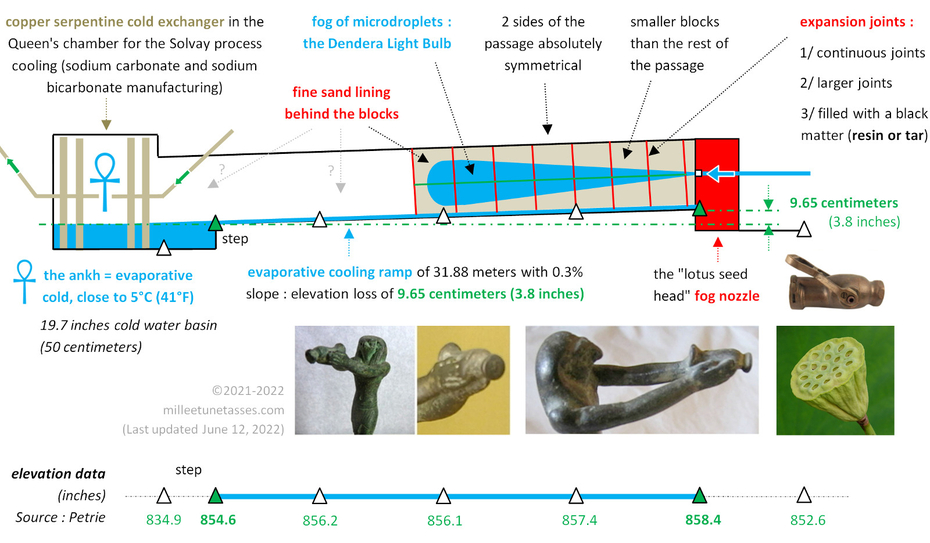
The fact that the Dendera Light is made of liquid water that transforms itself in a magical way, is exactly what are describing ancient Egyptians themselves : [About the snake inside the Dendera Light Bulb] "The field surrounding Ra’s snake form is referred to in ancient Egyptian literature as protective magical energy in liquid form that all gods and pharaohs possess (Faulkner 1970*)." https://ahotcupofjoe.net/2016/11/dendera-light-bulb-and-bagdad-battery-nonsense/
The evaporative cooling passage of the Great Pyramid of Giza and the Queen's chamber were discovered with a very hard encrustation of salt, up to one-half inch (1.3 centimeter) thick. That salt is the signature of the evaporative cooling process.
Please read Section 17, about Akhenaten and Nefertiti, for the explanations of the Ankh being the symbol of the evaporative cooling.
The elevation loss of 3.8 inches is between the start of the collecting ramp (858.4 inches) and its end (854.6 inches). Elevation data (inches) : "The pyramids and temples of Gizeh", by Petrie, W. M. Flinders (William Matthew Flinders), Sir, 1853-1942 ; section 40 (page 66) : "Passage to Queen's Chamber"
The horizontal passageway inside the Great Pyramid of Khufu
The horizontal passage was an evaporating cooling unit for the sodium carbonate (natron) Na2CO3 production by a soda-ash ammonia Solvay process. The key element of the passage was a multi-needle fog nozzle, very similar to modern firefighter nozzles. The nozzle transformed the pressurized water coming from the inclined well into a fog of liquid microdroplets that would evaporate in the passage and cool down the air between 5°C and 10°C.
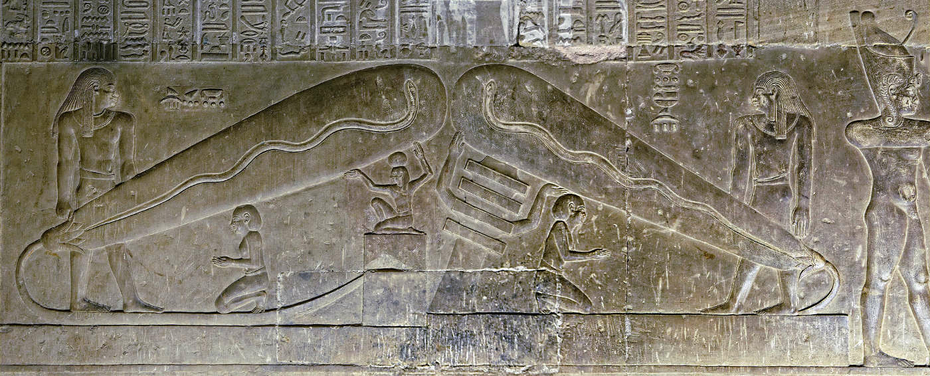
Dendera Light / The academic point of view
The scholar explanation of the famous stone reliefs in the Hathor temple at Dendera in Egypt, depict the Dendera Light "as God Harsomtus, in the form of a snake, emerging from a lotus flower in an oval container called hn, which might represent the womb of Nut. Sometimes a djed pillar supports the snake or the container." (Source : Wikipedia).
Photograph thanks to Kairoinfo4U on flickr : https://www.flickr.com/photos/manna4u/14525094039/in/photostream/
The reality is that the Dendera Light reliefs refer to the Great Pyramid of Khufu at Giza
Ancient Egyptians didn't have the technology that would give them electricity, they were doing chemistry and evaporating adiabatic cooling for an ammonia Solvay-like process that was only invented in the 1800s in Europe. The cold was stored inside the Queen's chamber, where the temperature could probably have been as low as 5°C (41°F) and transferred to the natron production unit by the 2 shafts.
On the Dendera Light reliefs, the theoretical part of the basic principle is carved on the left side of the relief : the character is offering the fog (the cold) ; and the practical application is on the right of the relief with the use of the cold for the counterflow chemical reaction tower (the Djed Pillar), through the 2 shafts of the Queen's chamber (the arms of the relief).
The double outline of the 2 characters holding and offering the Dendera Light Bulb, is the proof that the bulb was producing cold. They were cold themselves and they were represented having the goose bumps.
And everything I've just said, is carved into the famous stone reliefs in the Hathor temple at Dendera, showing the Dendera Light Bulb.
The above Dendera Light details, inside the Hathor temple in Egypt, are showing this unique and outstanding double outline of the character offering the bulb : he was offering cold and he was cold himself.
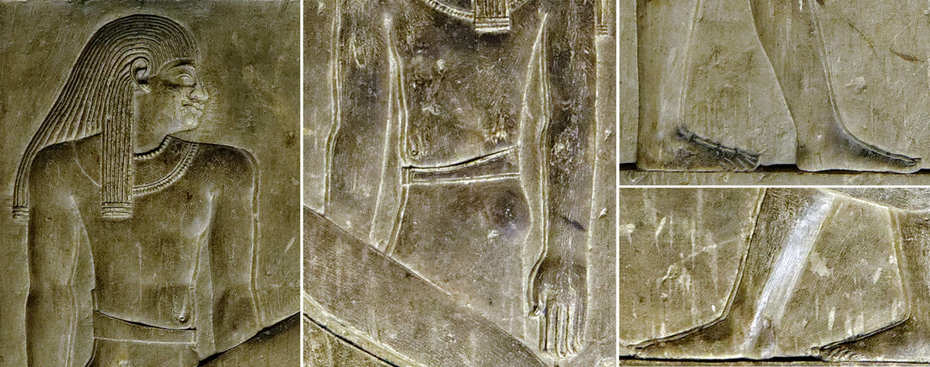
The "double outline" of the character producing and offering the Dendera Light fog
This "double outline" isn't discussed at all by anybody, though it is the most important element of the Dendera reliefs. The fog is made of microdroplets of liquid water and it would evaporate itself, taking the necessary energy from the air. The result is the cooling down of the air. The character is offering cold, and he is cold himself.
The "double outline" of the offering fog character of the Dendera Light reliefs, shows the goose bumps. He was cold himself.
Actually, everything depends on the capacity of the air to absorb humidity. The example shown on the Carrier Diagram below, tells us that it was probably very easy to cool down the air next to 10°C, if the air started at a 10% humidity rate, and got to 90% at the end of the process.
But, I think they could cool down the air a lot more than that. Because at the entry of the pyramid, was certainly installed a liquid dehumidifier, working with a salt brine solution. The air at the beginning of the cooling process was probably close to 5% humidity or lower ; and the air inside the horizontal passage probably closer to 100%.
In my opinion, in regards to the extensive efforts to minimize the thermal stress on the first part of the horizontal passage, and the first part only, particularly the sand added behind the blocks and the large expansion joints, I wouldn't be surprised they got close to 5°C in the Queen's chamber (41°F).
The "Power of Water" and the "Bristling Hair" reference in the Book of the Dead of Ani
That double outline of the Dendera relief character, being a representation of the goose bumps that results of cold temperatures induced by the association of air and water, is actually present in the Egyptian Book of the Dead of Ani.
The following excerpt comes from the papyrus of Ani, Egyptian Book of the Dead (240 BCE), translated by E.A. Wallis Budge (last third of the page) : http://www.ancienttexts.org/library/egyptian/bookodead/book5.htm
"The Chapter Of Breathing The Air And Of Having Power Over Water in Khert-Neter."
"The Osiris Ani saith: Open to me! Who art thou? Whither goest thou? What is thy name? I am one of you. Who are these with you? The two Merti goddesses (Isis and Nephthys). Thou separatest head from head when [he] entereth the divine Mesqen chamber. He causeth me to set out for the temple of the gods Kem-heru. "Assembler of souls" is the name of my ferry-boat. "Those who make the hair to bristle" is the name of the oars. "Sert" ("Goad") is the name of the hold. "Steering straight in the middle" is the name of the rudder; likewise, [the boat] is a type of my being borne onward in the lake. Let there be given unto me vessels of milk, and cakes, and loaves of bread, and cups of drink, and flesh, in the Temple of Anpu."
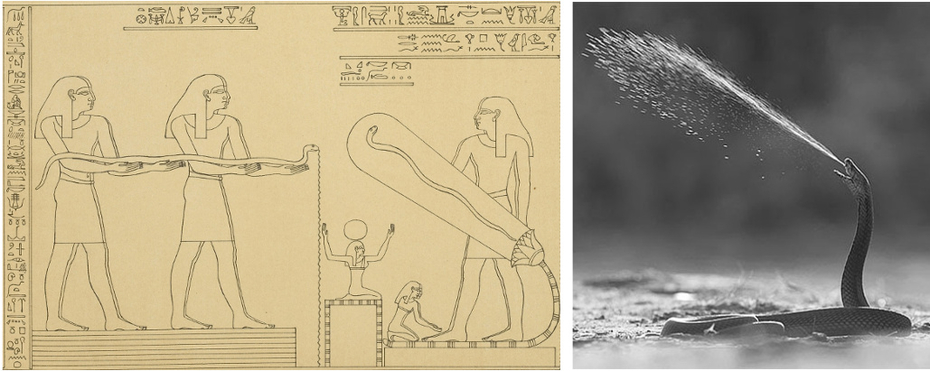
Dendera Light relief drawing on the left : please notice that what seems to be important here isn't the snake, but the spat venom of the snake. Also, you can see that the characters holding the snake are showing a double outline, the same way that the character holding (or offering) the Dendera Light does, on the right part of the drawing. The Dendera Light is produced by the snake, or as explained : by the venom of the snake. This particular relief is describing how was produced the microdroplets fog of sprayed water. Dendera Light drawing from the New York Public Library (Digital Collections). Author : Auguste Mariette, 1821-1881
The venom spray of a spitting snake : the fog of microdroplets
In my theory, the ascending passage of the Great Pyramid, is flooded and the fall of an impactor (wooden cradle float + granite block), pressurizes the ascending passage (the inclined well) and so generates high-pressurized water that is sprayed inside the horizontal passage into a microdroplets fog, that instantly vaporizes itself and by doing so, cool down the air temperature. This is an adiabatic cooling process, that can cool down the air very effectively, with a 15 to 20°C drop.
That fog of liquid water microdroplets, is the Dendera Light.
That drawing of one of the Dendera Light reliefs, is absolutely outstanding, because it is organized the same way we do today in every single science book : the theoretical part on one side and the practical part on the other side.
On the left side of the drawing, we can see that the key element is the spat venom of the snake and not the snake by itself : that represents the sprayed water ; and on the right side we can see the practical application of the concept inside the horizontal passage of the Great Pyramid : from the inclined well (the ascending passage), is the water pipe going to the fog nozzle and resulting in the microdroplets fog.
Please note that 1/ the angle of the Dendera Light Bulb is very similar to the angle of the typical venom spray of a spitting snake ; and 2/ the shape of the Light Bulb is very similar to the shape of the horizontal passage.

On these Dendera Light Bulbs reliefs, it is worth noting that the entire shape of the micro-droplets cooling fog entirely fits in a space that has the exact height of the passage where the process starts on the drawing it is on. Dendera Light drawing from the New York Public Library (Digital Collections). Author : Auguste Mariette, 1821-1881
The height of the Dendera Light Bulbs
On the left drawing, 1 and 1' have the same height. On the right drawing, 2 and 2' have the same height as well. And same thing on the drawing above, with the venom coming out of the snake : the height of the starting passage equals the maximum height of the fog.
The fog of microdroplets was limited by the height of the passage.
It is still unclear to me if that means that 1 and 2, strictly represent the horizontal passage of the Great Pyramid, where the cooling fog was created, or if it also includes the inclined well (the ascending passage) from where the pressurized water was coming from.

The Dendera Light Bulbs were producing cold and the adiabatic Carrier diagram can help us to evaluate how effective and efficient the cooling process was.
The character with the 2 knives
The Carrier diagram above, shows us that they probably didn't have any trouble getting to a 10°C inside the Queen's chamber (50°F) ; but like I said I wouldn't be surprised they could get to 5°C (41°F).
That minimum temperature is actually very important, because it could tell us precisely what process was used to make the sodium carbonate. It could have been the Solvay process, or the Hou process, which is a variant more effective.
For what I know, but I'm not a chemist, the cold could have been used for 2 major reasons : cool down the ammoniated tower where the brine (around 50% salt solution) was saturated with the ammonia NH3 and the carbonation tower where the ammoniated brine got saturated with CO2 coming from the kiln.
The character with 2 knives and a frog face, could maybe point to the good direction, because in the Hou process, a 10°C temperature is enough to cool down the carbonation tower and the ammonium chloride precipitate into the sodium chloride solution (the brine).
The precipitation of the ammonium chloride from the sodium chloride solution, results in a separation of the 2 components. And in my opinion, the separation of these 2 components is exactly what the 2 knives mean.
The knives are not here to protect anybody or anything, they don't even really mean cut.
The knives mean separate. There are 2 knives because 2 components needed to be separated.
The frog face of the character with the 2 knives
This is maybe a little far-fetched, but this frog face could also perfectly fit in the theory. Because, the precipitation of the ammonium chloride in the brine, is the separation of a solid component from a liquid phase.
And that is precisely what a frog do when passing from a tadpole living in the water, to an adult frog living in the air.
The frog face means separate from a liquid phase.
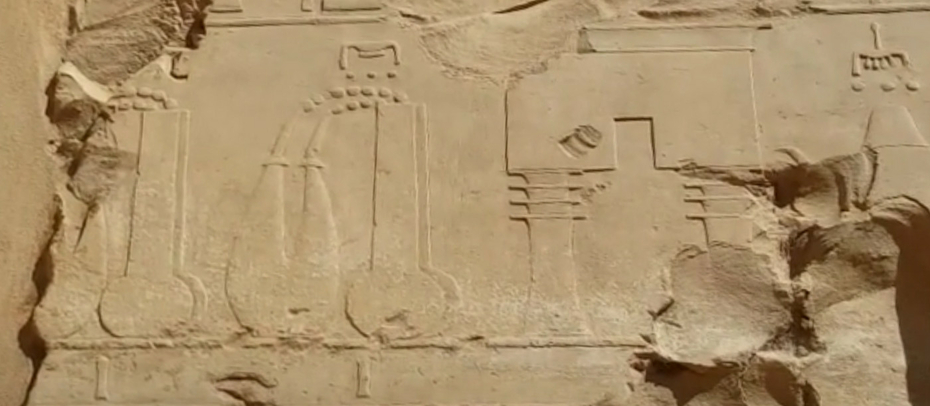
In most of the Dendera Light reliefs, also appear arms and Djed pillars. They are not mythological symbols. On that picture, we can see what is the real secret of the ancient Egyptians : chemistry. We can also see that the Djed pillars and the temples were both part of it. The magical part of the temples came from the chemistry craft.
The arms represent the Queen's chamber shafts for the cold transfer
Once the cold is produced inside the horizontal passage of the great pyramid, and stored inside the Queen's chamber, the sodium carbonate Solvay towers had to be cooled down. In my theory, the pyramid wasn't finished when operating : it had a flat roof at the Lady Arbuthnot level. The natron production site was situated at that level, and the towers probably cooled down by pumping water or directly a saline solution into the Queen's chamber where the copper serpentine cold exchanger was set.
The arms of the Dendera reliefs are the Queen's chamber shafts, and the Solvay towers are the Djed pillars.
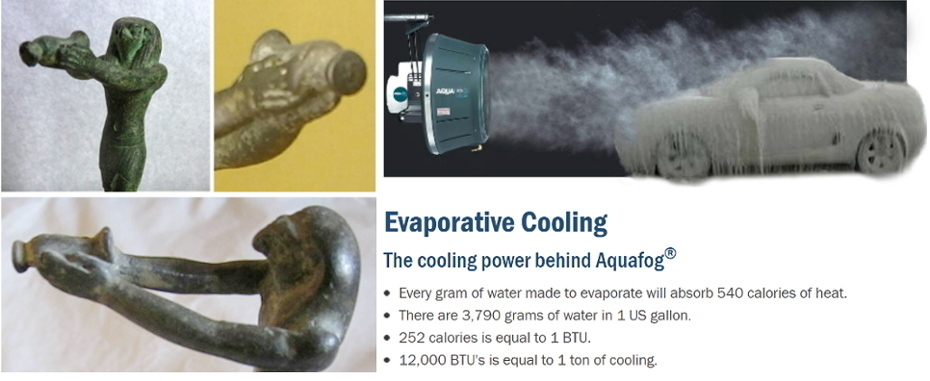
The ancient Egyptian god Horus, holding the fog nozzle of the evaporative cooling passage of the Great Pyramid.
Horus images : E3752 from the Louvre Museum and figurine of Horus DUT162 also from the Louvre Museum ; Paris, France, Hauteur : 9 cm ; Largeur : 2,7 cm ; Profondeur : 6 cm. Date de création/fabrication : Basse Epoque (664 - 332 BCE).
Evaporative cooling applications webpage screenshot : AquaFog® from Jaybird Manufacturing Inc (Pennsylvania, USA).
The surprising efficiency of the evaporative cooling process that created cold in the horizontal passage of the Great Pyramid of Khufu, is still used today in modern evaporative coolers
"Evaporative coolers lower the temperature of air using the principle of evaporative cooling, unlike typical air conditioning systems which use vapor-compression refrigeration or absorption refrigeration. Evaporative cooling is the conversion of liquid water into vapor using the thermal energy in the air, resulting in a lower air temperature". Source : Wikipedia

The name of the serpent goddess of embalming liquid Kebechet, that refreshes and purifies the pharaoh, means literally "cooling water"
This idea of a serpent representing water and cold, involved in the mummification process (the natron is the salt used for this occasion), and that progressively emerged from my work, is actually a genuine one, and she has a name : goddess Kebechet.
Wikipedia : "In Egyptian mythology, Kebechet (also transliterated as Khebhut, Kebehut, Qébéhout, Kabehchet and Kebehwet) is a goddess, a deification of embalming liquid."
"Her name means cooling water" and "in the Pyramid Texts, Kebechet is referred to as a serpent who "refreshes and purifies" the pharaoh..." . Also : "Kebechet was thought to give water to the spirits of the dead while they waited for the mummification process to be complete."
On this artifact of Kebechet, my interpretation is the following : the snake represents the entire sequence of the pressurized water spat out of the inclined well. The tail of the snake is the section of the well involved in the process, its body is the horizontal passage and its head is the fog nozzle. The structure on which the snake is put, is the horizontal passage itself, and it ends just after the step, before the entry to the Queen's chamber.

Hypothetical influence of Imhotep on pharaohs Djoser (Dynasty 3) and Sneferu (Dynasty 4) that could explain the fact he was represented with the wooden cradle float and/or the granite block weight.
Imhotep's "Refreshment of the Gods" Pyramid : the solution was here from the very beginning
Imhotep biggest influence was not in the medicine field, but in architecture. He is the one who built the first true pyramid in ancient Egypt, made of stone blocks and not dried mud bricks : the Djoser's Step Pyramid. Interestingly, this unprecedented step pyramid was called "The Refreshment of the Gods" ; and that obviously echoes the evaporative cooling process used in the Great Pyramid.
My conviction is that the term "refreshment" is not fully accurate: Imhotep's first pyramid was certainly not the "refreshment pyramid", but "the Pyramid of the cold".
Ancient Egyptians didn't master an ammonia Solvay-like process overnight : it had to be a long experimental journey, over many generations (the Disc of Sabu is dated from the First Dynasty, 3100 BCE to 3000 BCE ; and the Djed Pillars from even before that). Most probably, their biggest challenge from the beginning was cooling down the reaction chambers.
It is certainly not by accident that Imhotep not only was the first one to build structures out of limestone blocks, but also the first one to add columns to their design. Columns echoes to the Solvay towers but also to modern cooling towers (read the post about Sneferu's Red and Bent Pyramids for more on the subject).
Was Imhotep the real mastermind behind Sneferu's and Khufu's pyramids?
From Wikipedia : "Very little is known of Imhotep as an historical figure, but in the 3,000 years following his death, he was gradually glorified and deified. It appears that this libation to Imhotep was done regularly, as they are attested on papyri associated with statues of Imhotep until the Late Period (c. 664–332 BCE). Wildung (1977) explains the origin of this cult as a slow evolution of intellectuals' memory of Imhotep, from his death onward".
When Djoser died, Imhotep is thought to have gone on to serve his successors, Sekhemkhet (c. 2650 BCE), Khaba (c. 2640 BCE), and Huni, possibly Sneferu's father (c. 2630-2613 BCE). Scholars disagree on whether Imhotep served all four kings of the Third Dynasty but evidence suggests he lived a long life and was much sought after for his talents.
Maybe his ideas have been burrowed by his successor during the Fourth Dynasty, but most probably, in my opinion, he might as well also served Sneferu himself.
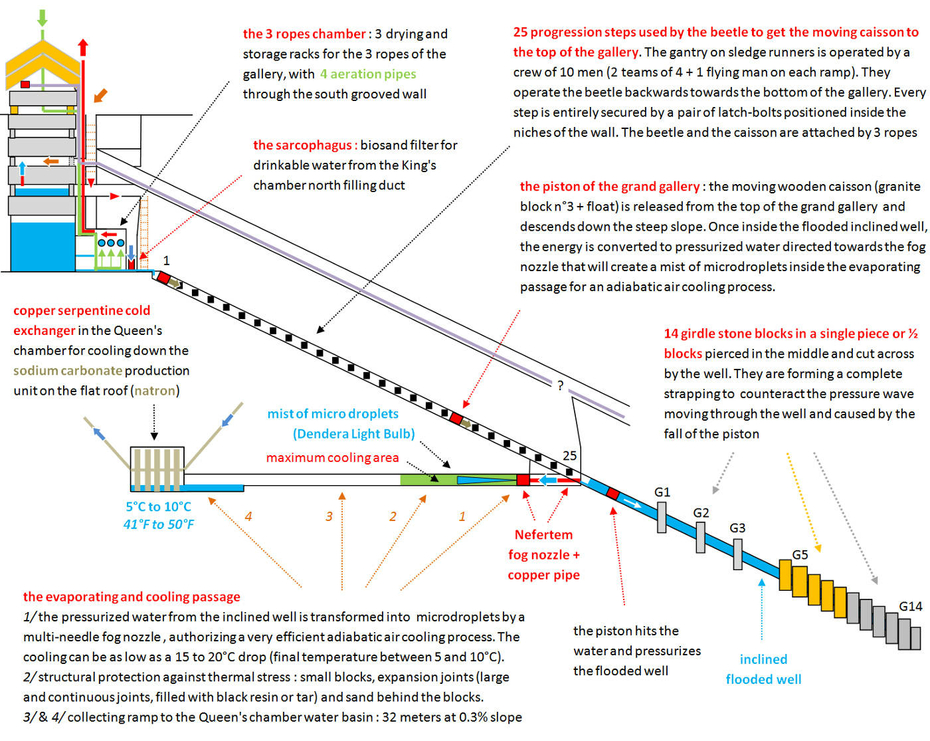
The Dendera Light explains how was operated the Great Pyramid of Khufu at Giza and what was its goal : the cold production inside the Queen's chamber, the only chamber that is located on the central axis of the pyramid.
The constant high humidity rate resulting of the evaporative cooling created in the horizontal passage and the Queen's chamber is explaining the presence of very thick and hard incrustation of salt in both of these parts of the Great Pyramid (read more on that subject in Section 1, paragraph 1.03).
The real secret of ancient Egyptians was chemistry manufacturing and it was perceived as a magical proof that they were having the legitimacy to reign from the gods
At the time of the pharaohs, they didn't use the modern term "sodium carbonate" : it was called natron and it was the mummification salt.
Pharaoh's Sneferu, Khufu's father, built 3 pyramids to master the production of this pure mineral form of the salt he was gonna use to access to immortality. If my theory is correct, the Great Pyramid of Khufu, at Giza, would be the achievement of his father's quest for immortality.
Chemistry was the real secret of the ancient Egyptians, probably for many generations before Sneferu ; and the technical mastery of this craft would have been a important piece of the political balance between the people and their kings.
People would probably only see magic in chemistry. For the people, it was the proof that their rulers had the legitimacy to reign, directly from the gods.
Chemistry was coming from the gods.
Sneferu was probably the most revolutionary pharaoh of all times, and he decided to deploy chemistry technology like never before. He didn't hesitate to build 3 pyramids and who knows how many smaller structures, to achieve the production of the pure natron.
The Great Pyramid at Giza should be seen, so to speak, as the fourth pyramid of Sneferu, the culmination of many years of hard work.
The pure natron produced inside the pyramids by Snefuru, had many advantages: they didn't have to rely on quarrying and purifying rocks, but I think the most important reason to do it, is that chemistry was probably seen at that time as close to magic as it could be.
Pharaoh's showing off their ability to master the chemistry crafts, was probably the cornerstone of their legitimacy to rule their kingdom. It was certainly assumed that the gods were giving that magical chemistry art directly to the pharaoh.
It is absolutely exhilarating to imagine what could have been that ancient Egyptian society, where most probably nobody had the right to even try to do any kind of chemistry, because it would have been perceived as an attempt to mimic the pharaoh's power and privileges.
Still, humans being what they are, some would have tried, and they would have been extremely severely punished for that.
The sacred and magic chemistry craft was the real secret and the real treasure of Ancient Egypt.
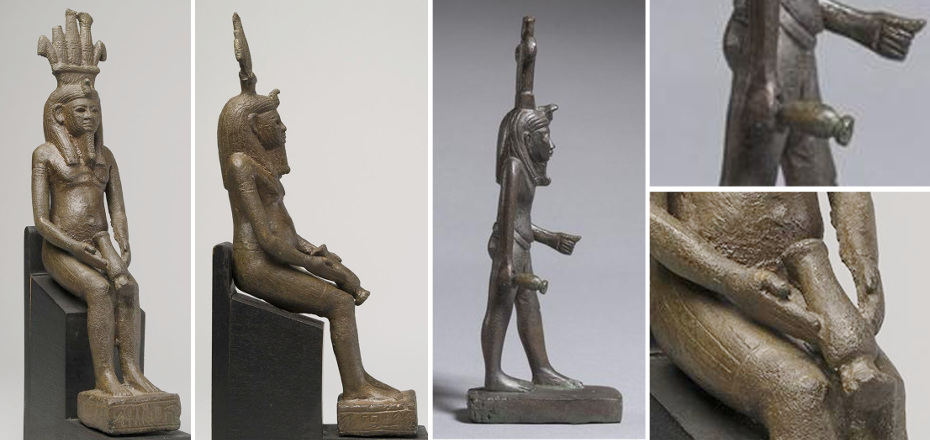
Hapi, the ancient Egyptian god of the Nile and flood. Left : Statue of the God Hapy. Late Period, Dynasty 26, VII–VI cent. B. C. © The Pushkin State Museum of Fine Arts. Right : Statuette du dieu de la crue du Nil Hâpi, N5030 from the Louvre Museum (via l’Agence photo de la Réunion des Musées nationaux et du Grand Palais © Musée du Louvre, Dist. RMN-Grand Palais / Christian Décamps).
Hapi, the god of the representation of the water supply of the pyramid, holding the evaporative cooling fog nozzle
Horus is not the only god holding the fog nozzle, here are other examples with the god Hapi. The way that Hapi is holding the fog nozzle should convince the greatest skeptics that this so particular element wasn't a libation vessel used for purification or baptism.
It is not a coincidence that Hapi is also holding the fog nozzle : Hapi was the god of the Nile, and we've already seen that the water used inside the Great Pyramid for the impactor to move and the cold to be produced, was most probably coming from the Nile.
Apep was the representation of the inclined well waters, pressurized by the fall of the impactor, and "Apep was seen as a giant snake or serpent leading to such titles as Serpent from the Nile" (Source : Wikipedia).
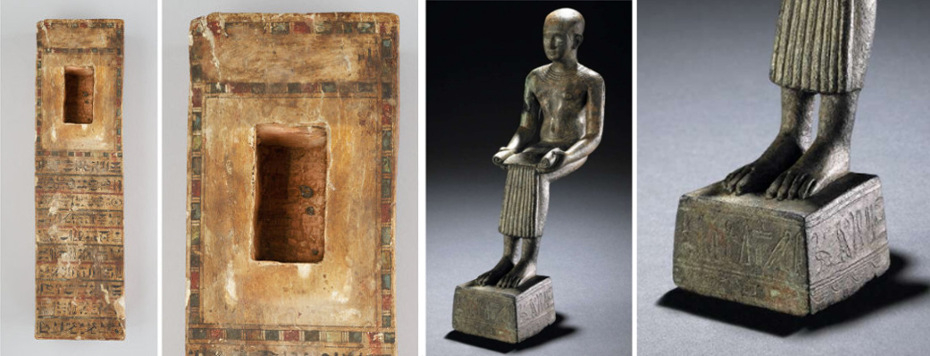
Left : Ptah-Sokar-Osiris Figure, 306–30 B.C. Metropolitan Museum of Art, New-York. On view at The Met Fifth Avenue. Photographs on the right : figure of Imhotep EA40666 from the British Museum.
The Ptah-Sokar-Osiris figure bases are representations of the wooden cradle float that was operated in the Great Pyramid
What is interesting in these photographs is not the hollow that have been made to insert the figurine base, but the rectangular shape empty of any marking, drawn around it and materialized by a thin black line : that was the real cavity where the granite block would have been inserted in.
Please note that the big rectangular area delimited by the thin black line and empty of any decoration, is not made for the foot of the mummy : it is way bigger. The mummy had clearly let a imprint inside the rectangular shape, it appears in a different yellowish color around the hole.
The representation of the granite block weight alone : the seated figures of Imhotep
Imhotep was a scientist, an architect and an engineer, so we shouldn't be surprised about the way he is depicted in his seated figurines : he holds the knowledge in his hands, seated with his feet in contact with what represented the most important piece of the Great Pyramid operating, the granite block that was inside the wooden cradle float.
We could argue that the "Imhotep's stone" is not the granite block that was inserted inside the wooden cradle float, and that it was just representing the fact that Imhotep was the first architect to use stone blocks instead of bricks.
But I don't think it is : on the Metropolitan Museum figurine of Imhotep donated by Padisu (first photograph above), this block quite doesn't show at all, and it is pretty much absorbed by the base, which I believe is the cradle, but here it doesn't really matter.
If the intent was to show a block because Imhotep used blocks, they wouldn't have quite completely hide it.
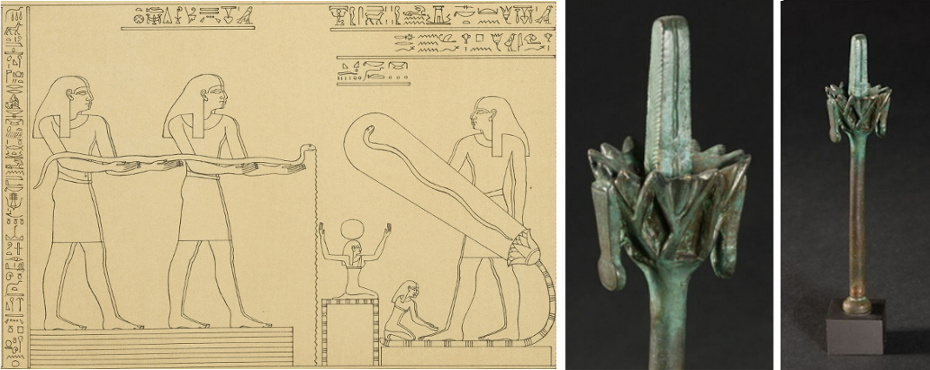
Ancient Egyptian god Nefertem emblem from the Louvre Museum in Paris, inventory number N 5118 / collections.louvre.fr ©Musée du Louvre/Christian Décamps.
The Nefertem emblems at the Louvre Museum : the water supplying pipe and the lotus flower fog nozzle
I really didn't expect to find any archeological find representing the fog nozzle and the pipe that was connecting it to the inclined well, but I think this is exactly what we have here, on the above and below photographs of Nefertem copper alloy emblem artifacts visible in the Louvre Museum. I presume the part getting upwards from the lotus flower is another representation of the fog of microdroplets.
I still don't know though what are representing the 2 pieces on the sides. They could be related to water, but they might be designed for dry air supply. This part of the global process will be the most difficult to decipher because contrary to pressurized water, air is so easy to move it doesn't require much equipment and leave very small amount of traces.

Nefertem amulets showing the Khepesh (right hand and shoulder). From left to right © British Museum EA64480, Le Louvre E 10665 and Le Louvre ME 299 (Nefertum emblem)
The Khepesh Scimitars of the Nefertem amulets were spanner wrenches for copper fittings
According to scholars, ancient Egyptian God Nefertem (also Nefertum, or Nefertemu) was the god of the lotus blossom who emerged from the primeval waters at the beginning of time. That would explains the huge lotus blossom that Nefertem amulets displayed on their heads.
But most of the time, Nefertem is also having a Khepesh-Scimitar on the right hand, that is described as a warfare blade with sharpened edges, even if many examples have dull edges that apparently were never intended to be sharp.
According to scholars, again, "it may therefore be possible that some Khepeshes found in high-status graves were ceremonial variants". But in my opinion, the idea that the reason why some Khepeshes weren't sharp at all, would be because they would have been for ceremonial use, couldn't be more wrong. Even today, the ceremonial Japanese katanas are maybe the most sharp of all katanas precisely because they are for ceremonial use. They are the best and the most expansive ones. The only katanas or any other kind of sword, that would be with dull edges, are the ones for kids to play, and they would be in plastic or wood.
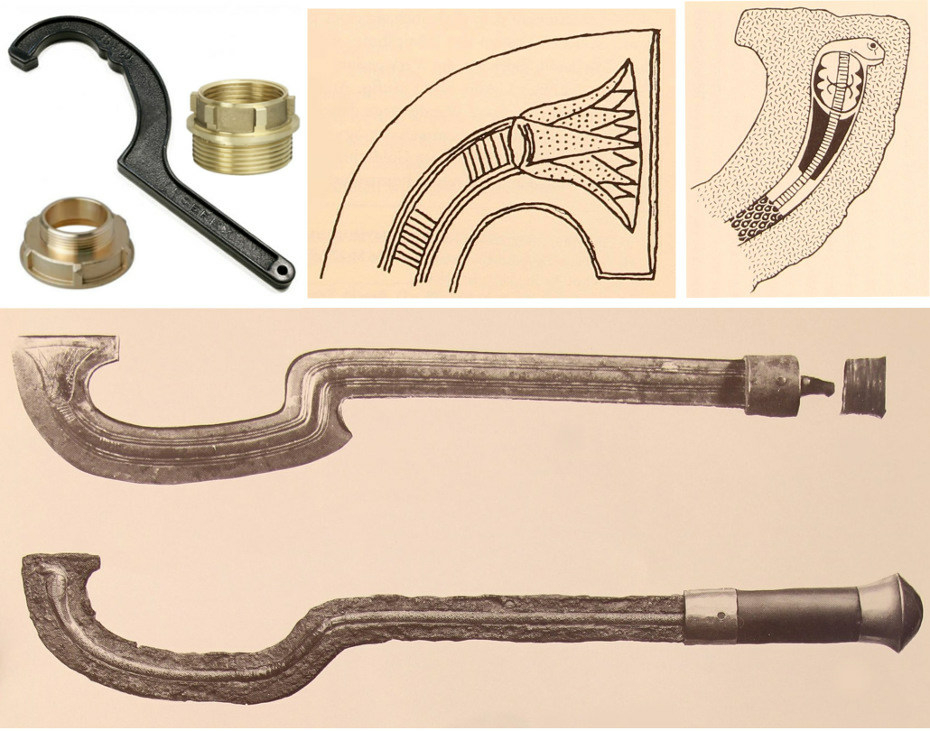
Top left photograph above : a modern spanner wrench designed to connect or disconnect metal fittings. The tooth at the end of the curved part of the tool is designed to engage onto the protuberances of the fitting. Other pictures are ancient Egyptians Khepesh Scimitars (exact dating is unknown to me).
Ancient Egyptians were using spanner wrenches (and screw fittings ?)
My interpretation of the Khepesh hold by Nefertem is radically different. I keep saying that pressurized water was directed towards the fog nozzle of the horizontal cooling passage of the Great Pyramid, and for that to be possible, pressure resistant pipes were needed, and that is exactly what is depicted in the Nefertem emblem.
But there is more, because to connect the pipe to the fog nozzle, or pipe pieces to each other, they would certainly have to use fittings. And as a former winemaker, I know one thing for sure about pipes and fittings : when you want to connect or disconnect these elements, you cannot do anything without a spanner wrench (maybe not in the US or in Canada where screw fittings are very rare, but in France, at least).
The Khepesh that Nefertem is holding isn't for warfare, it is a spanner wrench.
On certain representations of Nefertem, like E 10665 from the Louvre Museum (photograph above), we can also see on top of the Khepesh, a circular form in direct contact with the tool (though apparently not to scale). Could that round form be the copper fittings ?
The higher position of the tooth could indicate that the hook system was different from modern screw fittings
We can see on the ancient Egyptian Khepeshes that the tooth is placed higher in relation to the handle axis than on the modern spanner wrenches and it could mean that the hook system was different : on the modern tool, the tooth is designed to hook to an external piece of the screw fitting, but it is possible that on the ancient Khepeshes, there were sockets carved inside the fittings instead or that it wasn't at all screw fittings.

What is remarkable with these Khepeshes, is that they can probably indicate what was the pipe diameter they were designed for, and we can find out if different diameters were used or not. We also know they were probably using screw-type fittings.
Nefertem is the personification of the horizontal passage fog nozzle of the Great Pyramid.
To be convinced of this, please note that on these pictures above of 2 different Khepeshes, one is engraved with the lotus flower, while a snake appears on the other one, showing the 6 teeth / needles.
Both elements, the circular shape of the snake and the lotus flower, are representing the same thing : the fog nozzle.
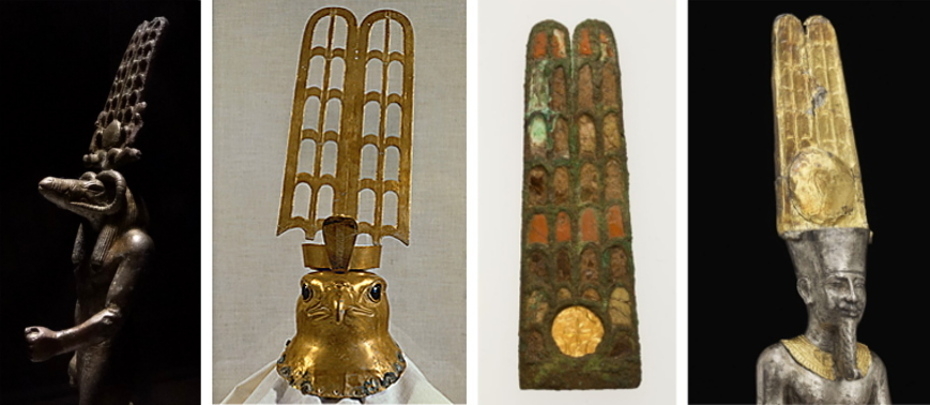
The Queen's chamber copper cold exchanger
Photographs above : we have what could be representations of the cold exchanger that were installed inside the Queen's chamber. I first thought it would take a modern copper serpentine appearance, but it was probably not, and maybe it looked exactly like on these photographs. If that is the case, probably dozens of these elements would have been connected in series inside the chamber.

The 25 sarcophagi of the Serapeum of Saqqara were sealed containers designed for the storage of the sodium carbonate Natron manufactured inside the Great Pyramid of Khufu.
The 25 sarcophagi of the Serapeum of Saqqara and the 25 progression steps of the Grand Gallery
We've seen that the Great Pyramid of Khufu at Giza was the culmination of a wonderful technological research program for sodium carbonate manufacturing, the purest mineral form of natron, the salt used by ancient Egyptians for the mummification process.
We've seen that what we see today of the Great Pyramid, but the subterranean chamber still totally unclear, was designed to produce cold inside the Queen's chamber and use it to cool down Solvay or Solvay-like towers, where discs of Sabu would have been set. The temperature inside the chamber would have been between 5°C and 10°C (41°F to 50°F).
The question now is, how long did the pyramid was in operation.
I've written in the Disc of Sabu and the Dendera posts, that it could have been "for days, weeks, maybe even months without ever stopping" but I was probably wrong : the Great Pyramid could have been operating maybe for a couple of years, or so. It would explain the presence of the ventilated antechamber that indicates that the pyramid had to be shut down for a while, probably many times and in respond to I presume, periods of drought ; and the so huge effect the pyramid had on ancient Egyptian culture (please read the post about the scarab amulets for more information about it).
Another way of addressing the question is trying to guess how much sodium carbonate did they manufactured. And we may be able to answer this question, because the entire production of the sodium carbonate had to be stored somewhere.
And I also think we know exactly where it was, because they absolutely needed to store the product away from humidity. The most obvious chemical property of the sodium carbonate, the reason why it was manufactured in the first place, is that it is a marvelous dehumidifier. If you want to store it over a long period of time, you need to do so in perfectly dry conditions. You need to store it in perfectly sealed containers.
I think the 25 sarcophagi of the Serapeum of Saqqara, were these containers.
The Great Pyramid and the Serapeum are only separated by 14 kilometers
On site, there are 24 sarcophagi, but there is another one which is now at the Agricultural Museum in Cairo. That is a total of 25 sarcophagi. Is there a connection to the 25 progression steps that were used inside the grand gallery ? I would say, probably yes.
Those Saqqara sarcophagi would have been perfect ancient sealed containers. The most important of their features would have been the extremely well finished surfaces where the sarcophagi would have been in contact with their lids. This surface is both very large and contrary to the rest of the boxes, not mirror like finished : it would avoid any significant passage of air from the outside of a sarcophagus to the inside.
The dating of the Sarcophagi of the Serapeum
Scholar's position is that "The most ancient burials found at this site date back to the reign of Amenhotep III, the ninth pharaoh of the Eighteenth Dynasty during the 1350s BCE." (from Wikipedia). But many people think the site is much more older, and that Amenhotep III rediscovered it and then reused it for his own purposes. To be more precise, it looks like the part where are the 24 sarcophagi left (25 at the origin), predates the rest of the complex.
My theory about the Great Pyramid, absolutely need these sarcophagi and I would really like to hear one day that the dating of the oldest part of the Serapeum of Saqqara had been corrected to the fourth Dynasty.
So what really was the natron for ?
If the 25 sarcophagi were really sealed containers for the sodium carbonate manufactured in the Great Pyramid, we are talking about tons of natron. Why did they want so much?
Were they experimenting with the liquid dehumidification mummification process with a natron solution instead of a conventional solid process?
Were the sarcophagi filled with powder natron or with a highly concentrated solution?
Was it only for mummification or did they use the sodium carbonate for other purposes. This mineral is nowadays produced in vast amounts and for many different purposes.
I've already submitted the hypothesis that pharaohs were using chemistry to prove to their people they were legitimate to reign, because gods were given to them the magical power. Was this natron used in temple ceremonies for demonstrations of this power?
It could be in particular in relation to the annual Djed pillar raising ceremony during the Sed festival.
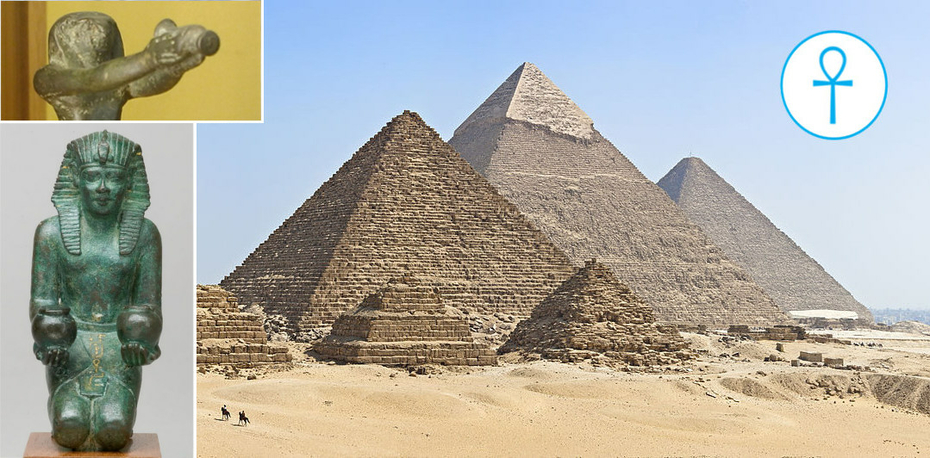
0.01 The Pyramids of the Cold - Very quick abstract of the study
Hidden behind the academic vision of the ancient Egyptian religion, a vast number of metaphors are describing some of the most advanced science and technological knowledge of that time.
Not only ancient Egyptian gods were pharaohs' metaphoric self-glorifications of their scientific accomplishments in physics and chemistry, but they also used this magical power to legitimate themselves as kings of Egypt.
Pharaohs forged an entire religion, based on science to become kings of Egypt. Magic was science.
The end game of this technological program was the Great Pyramid of Giza where evaporative cooling was engineered in the known part of the pyramid, using the power of water, most probably as suggested by the strong ammonia smell in the Red Pyramid, to cool down chemical manufacturing of sodium carbonate and sodium bicarbonate. At that time, sodium carbonate was called natron, and it was the salt used for the mummification of the pharaohs.
It means that ancient Egyptians were the first civilization to master a Solvay-like process for sodium carbonate manufacturing, long before it got reinvented in the 1800's in Europe. The key elements of that process is the temperature control of the chemical reactions (the cooling), and the dome shaped plate necessary for the counterflow chemical reactions to occur in an efficient way, and that plate is precisely what is the disc of Sabu.
Also, the very first pyramid complex, the Step Pyramid of Djoser, was called "the refreshment of the Gods".
0.02 The Pyramids of the Cold - Table of contents
Section 1 • The Evaporative Cooling Passage, Nefertem and the khepeshes
Section 2 • The Evaporative Cooling : the Dendera Light
Section 3 • The Evaporative Cooling : the Heka, Geb, Shu, Nut and Tefnut glorifying metaphors
Section 4 • The Inclined Well layout : the Girdle Stones and the interlocked blocks
Section 5 • The Inclined Well waters : the Apep metaphor of the pressurized waters
Section 6 • The Inclined Well : the Taweret Lady of the Well block
Section 7 • The Inclined Well : the Bes wedging block and the Māori ceremonial Haka
Section 8 • The Inclined Well : the draining of the well
Section 9 • The Inclined Well : the Was Scepter, the Sa Symbol and the Isis Knot
Section 10 • The Impactor
Section 11 • The Grand Gallery : the Hidden Hauling Cavern of the Underworld
Section 12 • The Grand Gallery : the Hauling Beetle designed for 8+2 crewmembers
Section 13 • The Grand Gallery : the Scarab Amulets
Section 14 • Solvay process (natron manufacturing) : the Red Pyramid
Section 15 • Solvay process (natron manufacturing) : the Disc of Sabu
Section 16 • Solvay process : the cooling of the Eye of Horus
Section 17 • The Ankh symbol and the changes made by Akhenaten & Nefertiti
Section 18 • The Sarcophagus of the Great Pyramid
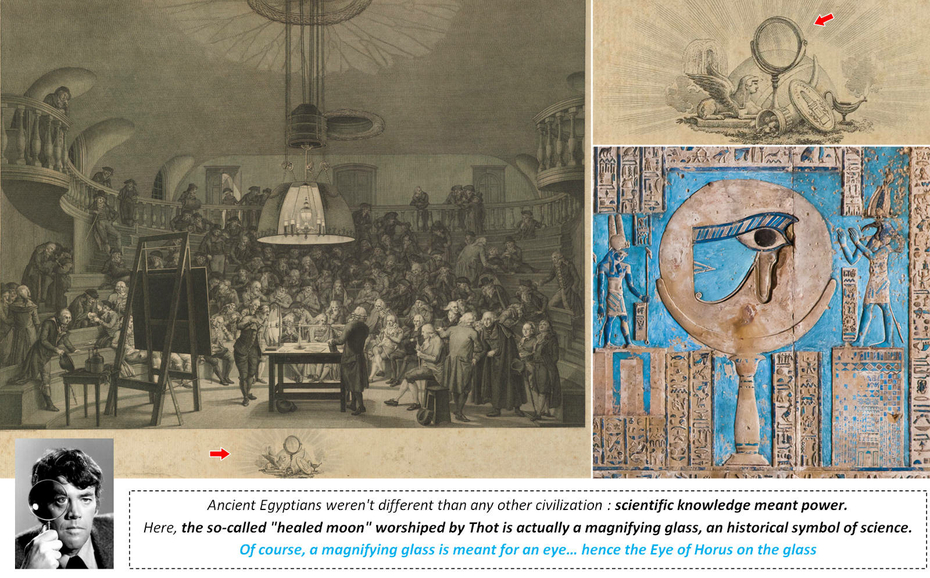
This engraving shows Dutch mathematician and physicist Jean Henri van Swinden (1746–1823) demonstrating the generation of electricity to the Felix Meritis Society in Amsterdam. The Felix Meritis Society was founded in the late 18th century to promote the arts and sciences (Felix Meritis translates as "Happiness through Merit"). Barbiers, Pieter Pietersz., and Jacques Kuyper. Courtesy of Science History Institute in Philadelphia : https://digital.sciencehistory.org/works/zg64tm573
The astronomical ceiling at the Pronaos : detail of the first Band west from the centre, showing the full "healed" moon on a pillar depicted as 'Wadjet' the Eye of Horus healed by Thoth, who is portrayed at the right. Thanks to Kairoinfo4U : https://www.flickr.com/photos/manna4u/9295311496
Jim Hutton as detective Ellery Queen, posing with a magnifying glass courtesy of NBC Television.
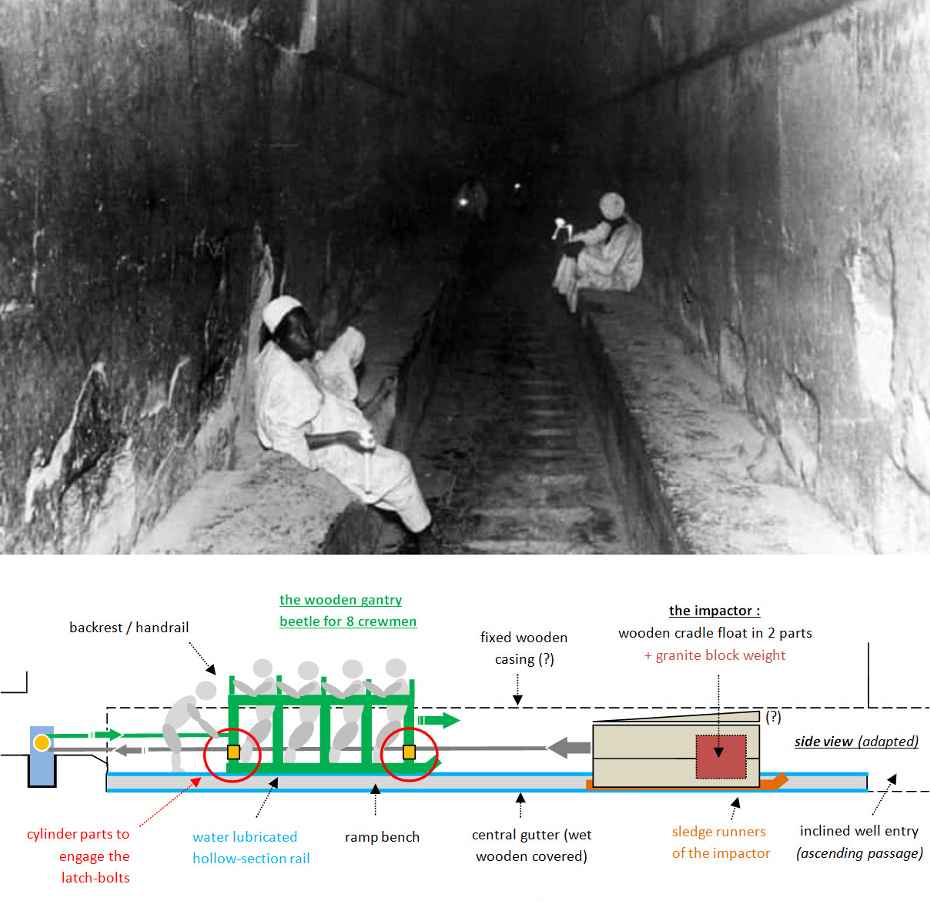
The Pyramids of the Cold - Section 12 • The Grand Gallery : the Hauling Beetle designed for 8+2 crewmembers

The Pyramids of the Cold - Section 7 • The Inclined Well : the Bes wedging block and the Māori ceremonial Haka
cherry morgan
Thank you for sharing such a fascinating blog post about the Dendera Light and its interpretation as an evaporative cooling fog. The connections you made between the representation of microdroplets of liquid water, the transformation into vapor, and the cooling effect on the Djed pillar were truly intriguing.
The inclusion of the snake inside the Dendera Light as a representation of pressurized water from the inclined well adds another layer of complexity to its symbolism. Your explanation of the ancient Egyptian literature referring to the field surrounding Ra's snake form as protective magical energy in liquid form further emphasizes the significance of this ancient artifact.
The references and sources provided in your blog post add credibility to the information shared and demonstrate a thorough understanding of the subject matter. I appreciate the effort taken to include external photographs and links for visual reference.
Overall, your blog post offers a unique perspective on the Dendera Light, delving into its symbolic meaning and ancient Egyptian beliefs. It's refreshing to see such detailed research and interpretation presented in a thought-provoking manner. Thank you for sharing your insights and shedding light on this intriguing ancient artifact.
Poster un commentaire
